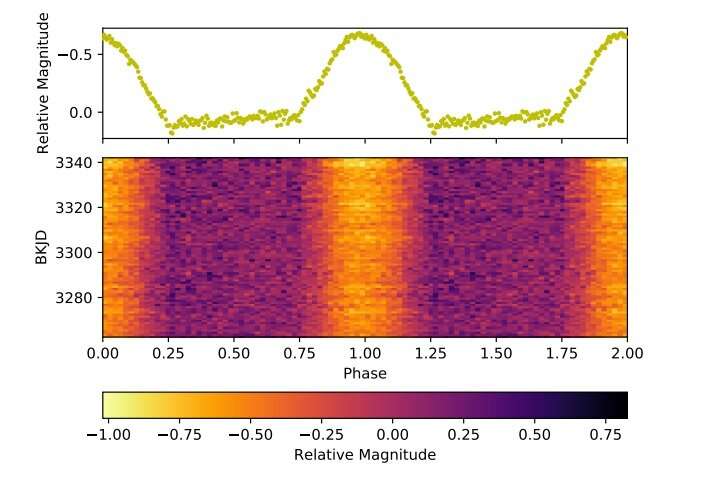September 3, 2019 report
Polar EU Cancri investigated with Kepler spacecraft

Using NASA's prolonged Kepler spacecraft mission, known as K2, astronomers have investigated a peculiar polar designated EU Cancri. The new observations, described in a paper published August 9 on arXiv.org, provide more insights into the nature of this intriguing object.
Cataclysmic variables (CVs) are binary star systems comprising of a white dwarf and a normal star companion. They irregularly increase in brightness by a large factor, then drop back down to a quiescent state. Polars are a subclass of cataclysmic variables, distinguished from other CVs by the presence of a very strong magnetic field in their white dwarfs.
EU Cancri (EU Cnc for short) is a polar in the open cluster M67. However, the distance to this object is still uncertain. A study published last year suggests that it is most likely located about 2,500 light years away, consistent with an estimated mean distance to the host cluster of around 2,900 light years.
Recently, a team of astronomers led by Katherine Hill of Bishop McGuinness Catholic High School in Oklahoma City, employed K2 to observe EU Cancri with the aim of getting more insights into the nature of this object. The polar was monitored by K2 during its Campaign 16 (from December 2017 to February 2018) and Campaign 18 (from May to July 2018). EU Cancri is so far the fourth polar observed by this spacecraft.
"Campaign 16 (C16) of the Kepler K2 mission continuously observed the system for 80 days at the one-minute short cadence and Campaign 18 (C18) did so again for 51 days at the thirty-minute long cadence. These observations are significant because EU Cnc is one of just four polars observed by the Kepler spacecraft," the astronomers wrote in the paper.
According to the study, the investigation of EU Cancri was challenging as the light curves provided by K2 are very faint. However, the researchers managed to collect fundamental information about the system.
Light curves from Campaign 16 and 18 showcase noisy, period humps every 2.1 hours. Therefore, the orbital period of the binary was calculated to be around 0.087 days.
Furthermore, the astronomers phased the light curve from Campaign 16 to the orbital period and averaged it into non-overlapping bins, which allowed them to extract a smooth, almost noiseless orbital waveform. This waveform exhibits a sharp, hump-like pulse and a faint region, each lasting for half of the orbit. The authors of the paper assume that such activity could be due to an accretion region rotating into and out of view.
The study also found brief, weak dips in the orbital waveform with a depth of around 10 percent at the beginning and end of the orbital hump. These dips have not been reported by previous studies and their origin remains unknown.
In general, the results seem to suggest that EU Cancri has potentially remained in a low-accretion state across its observational history. This assumption is based on the fact that no dramatic change in its orbital light curve has been observed over the past 30 years. Moreover, the orbital maxima of the light curve indicate magnetic accretion at a much lower mass-transfer rate than is typical for accreting pulsars.
Hence, taking into account the results, the astronomers concluded that EU Cancri could be a low-accretion-rate polar (LARP) in which accretion occurs via a magnetic siphon. "A magnetic siphon is a mechanism of mass transfer through which the secondary's entire stellar wind is captured, resulting in both weak X-ray emission and strong optical cyclotron harmonics," the researchers explained.
However, the presence of weak He I and He II emission in spectra of EU Cancri suggests a higher accretion rate than that usually found in LARPs. Therefore, the LARP scenario needs further investigation.
More information: Katherine Hill, et al. The Intriguing Polar EU Cancri in the Eyes of Kepler K2, arXiv:1908.08965v1 [astro-ph.SR]: arxiv.org/abs/1908.08965
© 2019 Science X Network





















